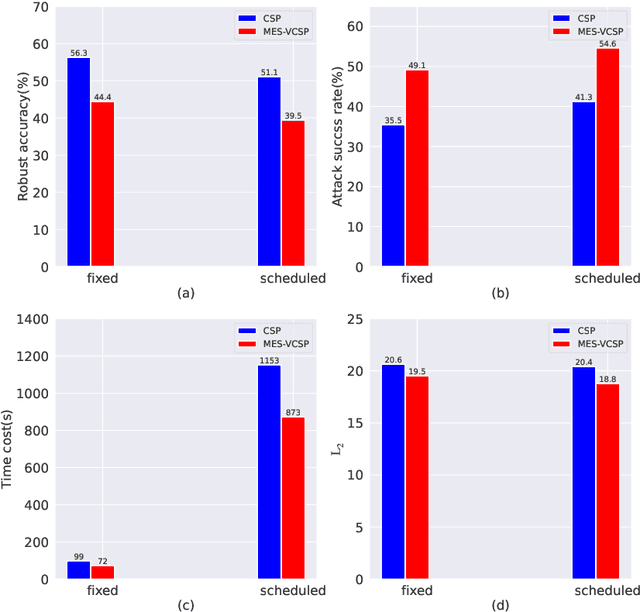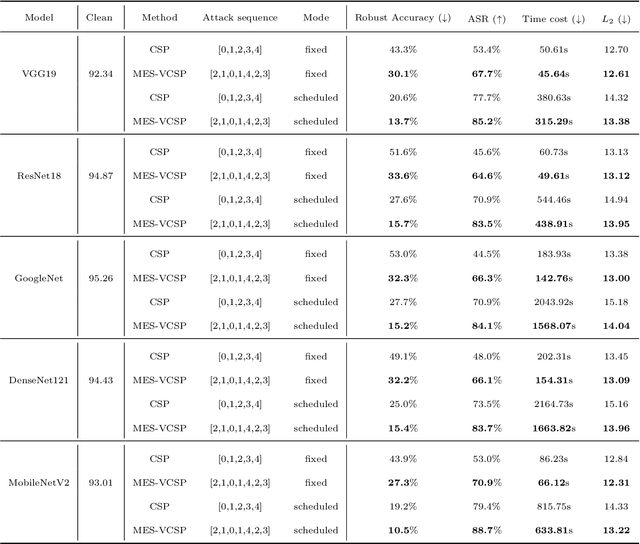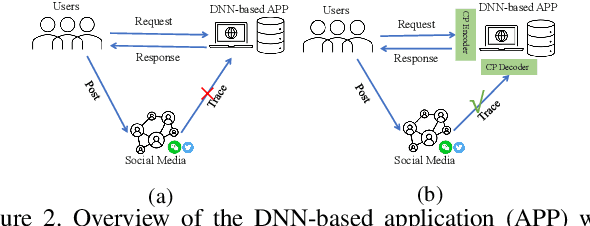Xiaoqian Chen
National Innovation Institute of Defense Technology, Chinese Academy of Military Science
PapMOT: Exploring Adversarial Patch Attack against Multiple Object Tracking
Apr 12, 2025Abstract:Tracking multiple objects in a continuous video stream is crucial for many computer vision tasks. It involves detecting and associating objects with their respective identities across successive frames. Despite significant progress made in multiple object tracking (MOT), recent studies have revealed the vulnerability of existing MOT methods to adversarial attacks. Nevertheless, all of these attacks belong to digital attacks that inject pixel-level noise into input images, and are therefore ineffective in physical scenarios. To fill this gap, we propose PapMOT, which can generate physical adversarial patches against MOT for both digital and physical scenarios. Besides attacking the detection mechanism, PapMOT also optimizes a printable patch that can be detected as new targets to mislead the identity association process. Moreover, we introduce a patch enhancement strategy to further degrade the temporal consistency of tracking results across video frames, resulting in more aggressive attacks. We further develop new evaluation metrics to assess the robustness of MOT against such attacks. Extensive evaluations on multiple datasets demonstrate that our PapMOT can successfully attack various architectures of MOT trackers in digital scenarios. We also validate the effectiveness of PapMOT for physical attacks by deploying printed adversarial patches in the real world.
Robust SAM: On the Adversarial Robustness of Vision Foundation Models
Apr 11, 2025Abstract:The Segment Anything Model (SAM) is a widely used vision foundation model with diverse applications, including image segmentation, detection, and tracking. Given SAM's wide applications, understanding its robustness against adversarial attacks is crucial for real-world deployment. However, research on SAM's robustness is still in its early stages. Existing attacks often overlook the role of prompts in evaluating SAM's robustness, and there has been insufficient exploration of defense methods to balance the robustness and accuracy. To address these gaps, this paper proposes an adversarial robustness framework designed to evaluate and enhance the robustness of SAM. Specifically, we introduce a cross-prompt attack method to enhance the attack transferability across different prompt types. Besides attacking, we propose a few-parameter adaptation strategy to defend SAM against various adversarial attacks. To balance robustness and accuracy, we use the singular value decomposition (SVD) to constrain the space of trainable parameters, where only singular values are adaptable. Experiments demonstrate that our cross-prompt attack method outperforms previous approaches in terms of attack success rate on both SAM and SAM 2. By adapting only 512 parameters, we achieve at least a 15\% improvement in mean intersection over union (mIoU) against various adversarial attacks. Compared to previous defense methods, our approach enhances the robustness of SAM while maximally maintaining its original performance.
A physics-driven sensor placement optimization methodology for temperature field reconstruction
Sep 27, 2024Abstract:Perceiving the global field from sparse sensors has been a grand challenge in the monitoring, analysis, and design of physical systems. In this context, sensor placement optimization is a crucial issue. Most existing works require large and sufficient data to construct data-based criteria, which are intractable in data-free scenarios without numerical and experimental data. To this end, we propose a novel physics-driven sensor placement optimization (PSPO) method for temperature field reconstruction using a physics-based criterion to optimize sensor locations. In our methodological framework, we firstly derive the theoretical upper and lower bounds of the reconstruction error under noise scenarios by analyzing the optimal solution, proving that error bounds correlate with the condition number determined by sensor locations. Furthermore, the condition number, as the physics-based criterion, is used to optimize sensor locations by the genetic algorithm. Finally, the best sensors are validated by reconstruction models, including non-invasive end-to-end models, non-invasive reduced-order models, and physics-informed models. Experimental results, both on a numerical and an application case, demonstrate that the PSPO method significantly outperforms random and uniform selection methods, improving the reconstruction accuracy by nearly an order of magnitude. Moreover, the PSPO method can achieve comparable reconstruction accuracy to the existing data-driven placement optimization methods.
Universal Multi-view Black-box Attack against Object Detectors via Layout Optimization
Jul 09, 2024



Abstract:Object detectors have demonstrated vulnerability to adversarial examples crafted by small perturbations that can deceive the object detector. Existing adversarial attacks mainly focus on white-box attacks and are merely valid at a specific viewpoint, while the universal multi-view black-box attack is less explored, limiting their generalization in practice. In this paper, we propose a novel universal multi-view black-box attack against object detectors, which optimizes a universal adversarial UV texture constructed by multiple image stickers for a 3D object via the designed layout optimization algorithm. Specifically, we treat the placement of image stickers on the UV texture as a circle-based layout optimization problem, whose objective is to find the optimal circle layout filled with image stickers so that it can deceive the object detector under the multi-view scenario. To ensure reasonable placement of image stickers, two constraints are elaborately devised. To optimize the layout, we adopt the random search algorithm enhanced by the devised important-aware selection strategy to find the most appropriate image sticker for each circle from the image sticker pools. Extensive experiments conducted on four common object detectors suggested that the detection performance decreases by a large magnitude of 74.29% on average in multi-view scenarios. Additionally, a novel evaluation tool based on the photo-realistic simulator is designed to assess the texture-based attack fairly.
Mammo-CLIP: Leveraging Contrastive Language-Image Pre-training (CLIP) for Enhanced Breast Cancer Diagnosis with Multi-view Mammography
Apr 24, 2024Abstract:Although fusion of information from multiple views of mammograms plays an important role to increase accuracy of breast cancer detection, developing multi-view mammograms-based computer-aided diagnosis (CAD) schemes still faces challenges and no such CAD schemes have been used in clinical practice. To overcome the challenges, we investigate a new approach based on Contrastive Language-Image Pre-training (CLIP), which has sparked interest across various medical imaging tasks. By solving the challenges in (1) effectively adapting the single-view CLIP for multi-view feature fusion and (2) efficiently fine-tuning this parameter-dense model with limited samples and computational resources, we introduce Mammo-CLIP, the first multi-modal framework to process multi-view mammograms and corresponding simple texts. Mammo-CLIP uses an early feature fusion strategy to learn multi-view relationships in four mammograms acquired from the CC and MLO views of the left and right breasts. To enhance learning efficiency, plug-and-play adapters are added into CLIP image and text encoders for fine-tuning parameters and limiting updates to about 1% of the parameters. For framework evaluation, we assembled two datasets retrospectively. The first dataset, comprising 470 malignant and 479 benign cases, was used for few-shot fine-tuning and internal evaluation of the proposed Mammo-CLIP via 5-fold cross-validation. The second dataset, including 60 malignant and 294 benign cases, was used to test generalizability of Mammo-CLIP. Study results show that Mammo-CLIP outperforms the state-of-art cross-view transformer in AUC (0.841 vs. 0.817, 0.837 vs. 0.807) on both datasets. It also surpasses previous two CLIP-based methods by 20.3% and 14.3%. This study highlights the potential of applying the finetuned vision-language models for developing next-generation, image-text-based CAD schemes of breast cancer.
Universal Perturbation-based Secret Key-Controlled Data Hiding
Nov 03, 2023Abstract:Deep neural networks (DNNs) are demonstrated to be vulnerable to universal perturbation, a single quasi-perceptible perturbation that can deceive the DNN on most images. However, the previous works are focused on using universal perturbation to perform adversarial attacks, while the potential usability of universal perturbation as data carriers in data hiding is less explored, especially for the key-controlled data hiding method. In this paper, we propose a novel universal perturbation-based secret key-controlled data-hiding method, realizing data hiding with a single universal perturbation and data decoding with the secret key-controlled decoder. Specifically, we optimize a single universal perturbation, which serves as a data carrier that can hide multiple secret images and be added to most cover images. Then, we devise a secret key-controlled decoder to extract different secret images from the single container image constructed by the universal perturbation by using different secret keys. Moreover, a suppress loss function is proposed to prevent the secret image from leakage. Furthermore, we adopt a robust module to boost the decoder's capability against corruption. Finally, A co-joint optimization strategy is proposed to find the optimal universal perturbation and decoder. Extensive experiments are conducted on different datasets to demonstrate the effectiveness of the proposed method. Additionally, the physical test performed on platforms (e.g., WeChat and Twitter) verifies the usability of the proposed method in practice.
Multi-objective Evolutionary Search of Variable-length Composite Semantic Perturbations
Jul 16, 2023



Abstract:Deep neural networks have proven to be vulnerable to adversarial attacks in the form of adding specific perturbations on images to make wrong outputs. Designing stronger adversarial attack methods can help more reliably evaluate the robustness of DNN models. To release the harbor burden and improve the attack performance, auto machine learning (AutoML) has recently emerged as one successful technique to help automatically find the near-optimal adversarial attack strategy. However, existing works about AutoML for adversarial attacks only focus on $L_{\infty}$-norm-based perturbations. In fact, semantic perturbations attract increasing attention due to their naturalnesses and physical realizability. To bridge the gap between AutoML and semantic adversarial attacks, we propose a novel method called multi-objective evolutionary search of variable-length composite semantic perturbations (MES-VCSP). Specifically, we construct the mathematical model of variable-length composite semantic perturbations, which provides five gradient-based semantic attack methods. The same type of perturbation in an attack sequence is allowed to be performed multiple times. Besides, we introduce the multi-objective evolutionary search consisting of NSGA-II and neighborhood search to find near-optimal variable-length attack sequences. Experimental results on CIFAR10 and ImageNet datasets show that compared with existing methods, MES-VCSP can obtain adversarial examples with a higher attack success rate, more naturalness, and less time cost.
RFLA: A Stealthy Reflected Light Adversarial Attack in the Physical World
Jul 14, 2023Abstract:Physical adversarial attacks against deep neural networks (DNNs) have recently gained increasing attention. The current mainstream physical attacks use printed adversarial patches or camouflage to alter the appearance of the target object. However, these approaches generate conspicuous adversarial patterns that show poor stealthiness. Another physical deployable attack is the optical attack, featuring stealthiness while exhibiting weakly in the daytime with sunlight. In this paper, we propose a novel Reflected Light Attack (RFLA), featuring effective and stealthy in both the digital and physical world, which is implemented by placing the color transparent plastic sheet and a paper cut of a specific shape in front of the mirror to create different colored geometries on the target object. To achieve these goals, we devise a general framework based on the circle to model the reflected light on the target object. Specifically, we optimize a circle (composed of a coordinate and radius) to carry various geometrical shapes determined by the optimized angle. The fill color of the geometry shape and its corresponding transparency are also optimized. We extensively evaluate the effectiveness of RFLA on different datasets and models. Experiment results suggest that the proposed method achieves over 99% success rate on different datasets and models in the digital world. Additionally, we verify the effectiveness of the proposed method in different physical environments by using sunlight or a flashlight.
Efficient Search of Comprehensively Robust Neural Architectures via Multi-fidelity Evaluation
May 12, 2023Abstract:Neural architecture search (NAS) has emerged as one successful technique to find robust deep neural network (DNN) architectures. However, most existing robustness evaluations in NAS only consider $l_{\infty}$ norm-based adversarial noises. In order to improve the robustness of DNN models against multiple types of noises, it is necessary to consider a comprehensive evaluation in NAS for robust architectures. But with the increasing number of types of robustness evaluations, it also becomes more time-consuming to find comprehensively robust architectures. To alleviate this problem, we propose a novel efficient search of comprehensively robust neural architectures via multi-fidelity evaluation (ES-CRNA-ME). Specifically, we first search for comprehensively robust architectures under multiple types of evaluations using the weight-sharing-based NAS method, including different $l_{p}$ norm attacks, semantic adversarial attacks, and composite adversarial attacks. In addition, we reduce the number of robustness evaluations by the correlation analysis, which can incorporate similar evaluations and decrease the evaluation cost. Finally, we propose a multi-fidelity online surrogate during optimization to further decrease the search cost. On the basis of the surrogate constructed by low-fidelity data, the online high-fidelity data is utilized to finetune the surrogate. Experiments on CIFAR10 and CIFAR100 datasets show the effectiveness of our proposed method.
A Plug-and-Play Defensive Perturbation for Copyright Protection of DNN-based Applications
Apr 20, 2023



Abstract:Wide deployment of deep neural networks (DNNs) based applications (e.g., style transfer, cartoonish), stimulating the requirement of copyright protection of such application's production. Although some traditional visible copyright techniques are available, they would introduce undesired traces and result in a poor user experience. In this paper, we propose a novel plug-and-play invisible copyright protection method based on defensive perturbation for DNN-based applications (i.e., style transfer). Rather than apply the perturbation to attack the DNNs model, we explore the potential utilization of perturbation in copyright protection. Specifically, we project the copyright information to the defensive perturbation with the designed copyright encoder, which is added to the image to be protected. Then, we extract the copyright information from the encoded copyrighted image with the devised copyright decoder. Furthermore, we use a robustness module to strengthen the decoding capability of the decoder toward images with various distortions (e.g., JPEG compression), which may be occurred when the user posts the image on social media. To ensure the image quality of encoded images and decoded copyright images, a loss function was elaborately devised. Objective and subjective experiment results demonstrate the effectiveness of the proposed method. We have also conducted physical world tests on social media (i.e., Wechat and Twitter) by posting encoded copyright images. The results show that the copyright information in the encoded image saved from social media can still be correctly extracted.
 Add to Chrome
Add to Chrome Add to Firefox
Add to Firefox Add to Edge
Add to Edge